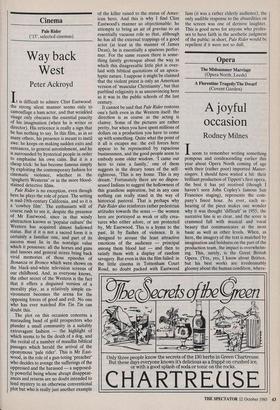Cinema
Pale Rider (`15', selected cinemas)
Way back West
Peter Ackroyd
It is difficult to admire Clint Eastwood: the strong silent manner seems only to camouflage a ham actor, and that wrinkled visage only obscures the essential paucity of his imagination (when he is writer or director). His reticence is really a sign that he has nothing to say. In this film, as in so many others, his presence is meant to instil awe: he keeps on making sudden exits and entrances, to general astonishment, and he is surrounded by hysterical people in order to emphasise his own calm. But it is a cheap trick: he has become famous simply by exploiting the contemporary fashion for cinematic violence, whether in the `spaghetti Westerns' or in the more blood- stained detective films.
Pale Rider is no exception, even though here he plays the role of priest. The setting is mid-19th-century California, and so it is a 'cowboy film'. The enthusiasts will of course rush to see it, despite the presence of Mr Eastwood, since in that windy abstraction known as 'popular culture' the Western has acquired almost hallowed status. But if it is not a sacred form it is certainly a familiar one, and part of its success must lie in the nostalgic value which it possesses: all the horses and guns and lassoes and general stores bring back vivid memories of those episodes of Bonanza or Bronco which were shown on the black-and-white television screens of our childhood. And, as everyone knows, the other secret of the Western is the fact that it offers a disguised version of a morality play, as a relatively simple en- vironment becomes the arena for the opposing forces of good and evil. No one who has ever watched Rin Tin Tin can doubt this.
The plot on this occasion concerns a marauding band of gold prospectors who plunder a small community in a suitably extravagant fashion — the highlight of which seems to be the death of a dog, and the recital of a number of maudlin biblical passages which herald the arrival of the eponymous 'pale rider'. This is Mr East- wood, in the role of a gun-toting 'preacher' who decides to avenge the sufferings of the oppressed and the harassed — a supposed- ly powerful being whose abrupt disappear- ances and returns are no doubt intended to lend mystery to an otherwise conventional plot but who is really just another example of the killer raised to the status of Amer- ican hero. And this is why I find Clint Eastwood's manner so objectionable: he attempts to bring an air of gravitas to an essentially vacuous role so that, although he has all the external trappings of a good actor (at least in the manner of James Dean), he is essentially a spurious perfor- mer. For the same reason there is some- thing faintly grotesque about the way in which this disagreeable little plot is over- laid with biblical quotations of an apoca- lyptic nature. I suppose it might be claimed that the violent priest is only an American version of 'muscular Christianity', but that purblind religiosity is as unconvincing here as it was in the public schools of the last century.
It cannot be said that Pale Rider restores one's faith even in the Western itself: the direction is as coarse as the acting is clumsy. Some of the pictures are rather pretty, but when you have spent millions of dollars on a production you have to come up with something. Quite what the point of it all is escapes me: the evil forces here appear to be represented by rapacious businessmen, and the good people seem to embody some older wisdom. 'I came out here to raise a family,' one of them suggests in the dreary tones of the self- righteous, 'This is my home. This is my dream.' Fortunately there are no dispos- sessed Indians to suggest the hollowness of this grandiose aspiration, but in any case nothing can really stand in the way of historical pastoral. That is perhaps why Pale Rider also reinforces rather pedestrian attitudes towards the sexes — the women here are portrayed as weak or silly crea- tures who either adore, or are protected by, Mr Eastwood. This is a, hymn to the past, lit by flashes of violence. It is designed to arouse the least attractive emotions of the audience — principal among them blood lust — and then to satisfy them with a display of random savagery. But even in this the film failed: in the little cinema in Tottenham Court Road, no doubt packed with Eastwood fans (it was a rather elderly audience), the only audible response to the absurdities on the screen was one of derisive laughter. This is good news for anyone who profes- ses to have faith in the aesthetic judgment of the public: in short, Pale Rider would be repellent if it were not so dull.






















































 Previous page
Previous page